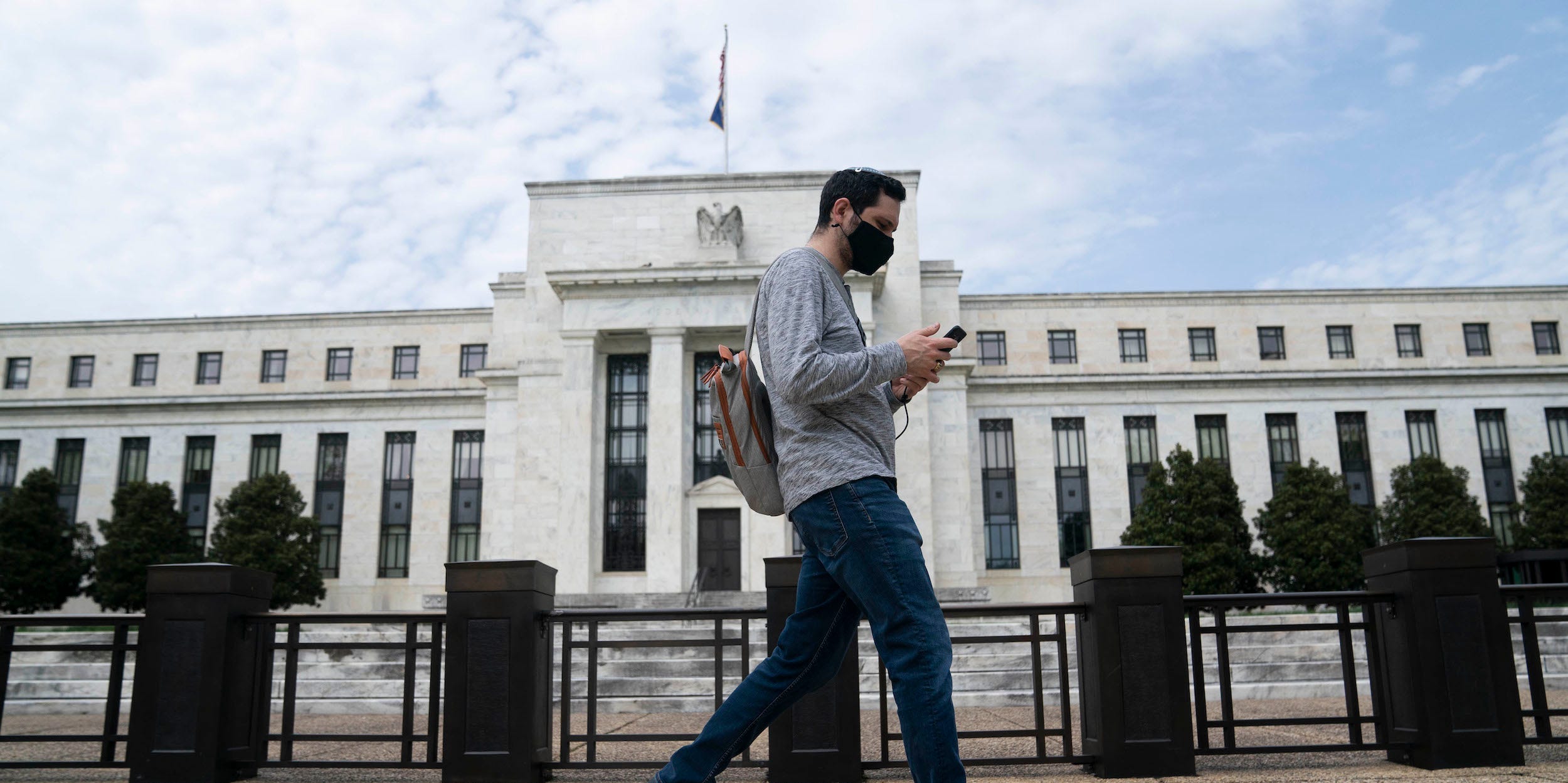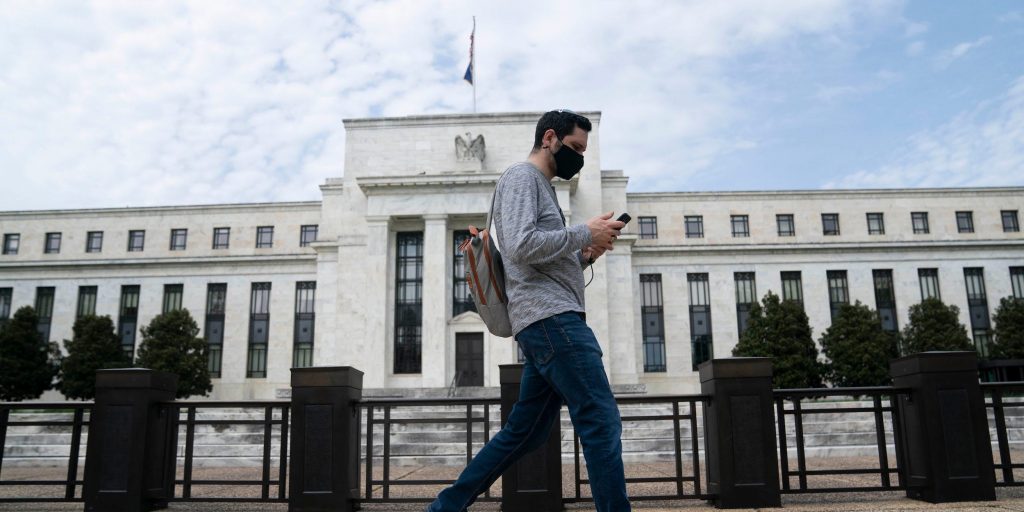
Liu Jie/Xinhua/Getty Images
- The Federal Reserve influences nearly all parts of the US economy. But most Americans don't know about it.
- The Fed acts as America's bank, and its actions affect everything from loan costs to stock prices.
- Here's a guide to the Fed, what it does, and why you should care.
- See more stories on Insider's business page.
If you've ever taken out a loan, held cash in a savings account, saved for retirement, or received a stimulus check during the pandemic, the Federal Reserve played a role in your financial life.
Most Americans know next to nothing about it – more than 75% polled by Ipsos for Axios said they know "a little" or less about the Fed and what it does.
Imagine an entity that creates money out of thin air with just a few keystrokes. A bank so powerful that it could lend a country trillions of dollars in a crisis. What if this institution could influence how rich or poor you are, along with hundreds of millions of Americans, and, indirectly, billions of people around the world?
That's the Fed.
That power is why some people think it's dangerous. Former Texas Congressman Ron Paul rose to fame on the back of his "audit the Fed" platform, which then significantly influenced Republican politics.
Others dislike the Fed for its independence. President Donald Trump repeatedly grilled the central bank for not lowering interest rates at his behest. And on the other end of the political spectrum, Democrats have criticized the Fed for not doing enough. Progressives have called on the Fed to more aggressively regulate banks, combat climate change, and address economic inequality.
To understand why the Fed is so polarizing, one must understand the central bank. Here's Insider's guide to the Fed, what it does, and why you should care.
What is the Fed?
Put simply, the Fed controls the money that flows through the US economy. It acts as the country's bank by processing transactions between the government and Americans, as well as ensuring banks can dole out loans. It also stabilizes the financial system in times of crisis by lowering borrowing costs and keeping financial markets afloat.
More specifically, the central bank is responsible for two goals established by Congress: maximum employment and stable price growth. This is often referred to as the Fed's "dual mandate."
A group of Fed officials, known as the Federal Open Market Committee, meets eight times each year to review its policy stance and adjust it as needed to meet the two goals. Meetings end with a statement from the Fed and a press conference held by the central bank's chair, Jerome Powell.
While the Fed's goals come from Congress, the two bodies are independent. Its policy decisions don't come from lawmakers or the president, and it doesn't receive funding from Congress. The president does appoint governors to the Fed's board, but Fed officials will be quick to note that their actions are theirs alone. By operating independently, the Fed can assure its policy actions are nonpartisan and not tainted by any politician's desire for a stronger economy.
The Fed is also separate from the US Mint. The Mint, which operates as part of the Treasury Department, is responsible for physically printing dollars. The Fed, however, sends the order to print dollars and directs where those dollars are sent.
What does the Fed do?
The Fed uses a handful of tools to pursue its two goals. Principal among them is the federal funds rate, the benchmark to which all interest rates on mortgages, loans, and credit cards are linked. When the central bank wants to encourage borrowing to put more money in Americans' hands, it will lower the federal funds rate. That then lowers rates at banks, lenders, and other financial institutions across the country and makes money more accessible to everyday Americans.
The Fed can also raise rates if it fears too much money is moving through the economy and causing prices to skyrocket. Higher rates make borrowing more expensive, and Americans typically spend less and save more when rates are high. Rate hikes tend to happen in periods of strong economic growth, while cuts happen during recessions.
During times of crisis such as the coronavirus pandemic, the central bank can also help banks out by purchasing two kinds of assets: Treasury bonds and mortgage-backed securities. The idea is that such programs -known as quantitative easing - help financial markets function smoothly by supplying cash for them to lend and invest. This helps keep the economy stable.
Why should I care?
The Fed's control of interest rates touches nearly all parts of the economy. When the Fed lowers rates, payments on loans, credit cards interest, and mortgages also decline. Americans also tend to save less because they earn smaller returns on cash they park in the bank. This usually encourages people to borrow more and spend more on expensive items, as it's cheaper to buy a home or car when rates on loans are lower.
Higher rates have the opposite effect. Mortgage rates, credit-card payments, and debt payments climb when the Fed lifts its benchmark rate. High-rate environments are less kind to borrowers, but savers enjoy larger interest payments.
The Fed's rate decisions also have an indirect impact on your stock market investments. When the Fed announces - or even hints at - a rate hike, stocks tend to drop sharply. This is because when rates are high, investors see a higher return by purchasing Treasury bonds or parking their money in savings accounts. Conversely, rate cuts tend to boost stocks since lower rates tend to encourage borrowing, spending, and business investment.
Commentary around the Fed's purchasing of MBS and Treasurys from banks can have similar effects. Stocks tend to drop when the Fed hints at paring back purchases, as such a retreat would mean less money flowing into banks to support lending and investing.
The Fed knows just how much its statements can rock markets, and is usually tight-lipped with regard to future policy adjustments. Officials rarely give substantive hints at how the Fed will act. And since the central bank doesn't want to influence markets, policymakers' statements can often be short and vague.
What is the Fed doing now?
The coronavirus pandemic powered the worst economic recession in nearly a century, and the Fed's intervention was similarly historic.
The Fed rolled out a bevy of supportive policies just days into the US outbreak in March 2020. It swiftly cut interest rates to their all-time low of nearly zero and announced $700 billion in asset purchases.
The Fed also created a handful of lending programs to lower borrowing costs for businesses, corporations, and nonprofits.
The central bank is still holding rates near zero and buying at least $120 billion in assets each month. All of its pandemic-era lending facilities have ended operations, with the last of one closing on July 30. Participants in the FOMC's July meeting suggested the Fed could start shrinking its asset purchases before the end of the year, but details on timing remain scarce.
Dit artikel is oorspronkelijk verschenen op z24.nl

